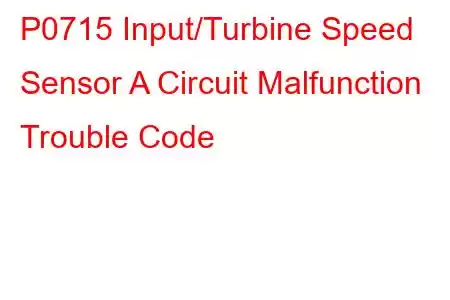P0715 Input/Turbine Speed Sensor A Circuit
OBD-II Trouble Code Technical Description
Input/Turbine Speed Sensor A Circuit
This diagnostic trouble code (DTC) is a generic powertrain code, which means that it applies to all 1996-newer vehicles (Ford, Honda, Mazda, Mercedes, VW, etc.). Although generic, the specific repair steps may vary depending on make/model.
What does that mean?
When I have encountered a diagnostic trouble code P0715, it has been due to the powertrain control module (PCM) detecting a malfunction in the circuit for the designated input (or turbine) speed sensor known as A. Input and turbine speed sensors are virtually identical in design. The difference is primarily with the descriptive terminology. The A designation is typically reserved for OBD-II equipped vehicles that use multiple input or turbine speed sensors. Consult the manufacturer’s service manual for the location of the input/turbine sensor designated A.
The input/turbine speed sensor is usually an electromagnetic, 3-wire sensor used to monitor transmission input speed (recognized by the PCM as revolutions per minute or RPMs). The sensor is positioned near the rear of the torque converter (at the transmission input shaft) and is either mounted with a bolt/stud or threaded directly into the transmission case.
On the transmission main (or input) shaft, specially designed grooves (or a notched reluctor wheel) are present. The input shaft (or reluctor wheel) passes in close proximity to the end of the sensor; completing the electromagnetic circuit. As the grooves (or notches) pass by the sensor, the circuit is interrupted and an electronic pattern is formed. This pattern formation is received by the PCM as a waveform pattern that it further interprets as transmission input/turbine speed.
Transmission input/turbine speed is compared with engine RPM speed, percentage of engine load, transmission output speed, and vehicle speed to determine the desired input speed RPM. If the actual input/turbine speed fails to coincide with the desired input/turbine speed, a code will be stored and a malfunction lamp may be illuminated.
Symptoms & Severity
In some instances, this code being stored will prompt the PCM to place the transmission in ‘limp-in’ mode. In this mode, the transmission will shift harshly. If you are presented with a P0715 and the transmission begins to shift irregularly, the problem must be addressed as soon as possible.
Symptoms of a P0715 code may include:
Harsh or erratic transmission shift points Failure of the transmission to shift Decreased fuel efficiency Speedometer (odometer) fluctuation Lack of speedometer (odometer) operation In some cases, when coming to a stop the engine may stallCauses
Potential causes for this code to set are:
Defective input speed sensor Faulty output speed sensor Damaged, worn, or broken reluctor ring or shaft Bad transmission torque converter Loose, burned, or otherwise damaged wiring and/or connectors PCM failure or programming errorDiagnostic and Repair Procedures
A good starting point is always to check for technical service bulletins (TSB) for your particular vehicle. Your issue may be a known issue with a known fix put out by the manufacturer and can save you time and money during diagnosis.
A suitable diagnostic scanner, a digital volt/ohmmeter (DVOM), a system wiring diagram, and possibly an oscilloscope will be helpful in diagnosing the P0715 code.
Skilled technicians usually begin with a visual inspection of system wiring and connectors. Repair or replace disconnected, corroded, burnt, or shorted parts as needed. Test the battery and inspect battery cables and cable ends. Remove corrosion and secure battery terminals as required.
Connect the scanner to the diagnostic port and retrieve all stored codes. Make a
Read: 29


